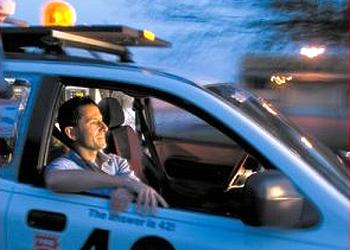
AUSTIN, Texas, August 27, 2015 (ENS) – The self-driving cars of the future will make “reservations” to cross intersections, if a system under development at the University of Texas, Austin is adopted by the U.S. Department of Transportation.
The precision with which self-driving vehicles can be controlled at intersections is key to the benefits they offer: improved safety, less congestion, lower emissions, and less wasted time and fuel.
The U.S. Transportation Department has been working on the problem of controlling self-driving vehicles at intersections for the past seven years.
A research project on intersection control for autonomous vehicles, awarded by the Federal Highway Administration’s Exploratory Advanced Research Program in 2008, is taking place at the University of Texas, Austin.

UT professor of computer science Peter Stone, who heads the research team, says intersections of the future will not need stop lights or stop signs. “They will look like a somewhat chaotic flow of driverless, autonomous cars slipping past one another, managed by a virtual traffic controller,” he said.
“A future where sitting in the backseat of the car reading our newspaper while it drives us effortlessly through city streets and intersections is not that far away,” said Stone.
Stone and his team propose an intersection control system using current or near-term sensor technologies, a standardized communication protocol, and the ability to deploy gradually over time to safely accommodate a mix of autonomous and human-driven vehicles in changing proportions.
For intersection control, the researchers are developing a system of “reservations,” in which a vehicle approaching the intersection “calls ahead” via digital short-range communications to the “intersection manager” to request a block of space and time to cross the intersection.
The request transmits the vehicle’s time of arrival, velocity, size, acceleration capability, and arrival and departure lanes.
An intersection controller then simulates the vehicle’s trajectory across the intersection, calculating the clear space required for passage. It approves or denies the vehicle’s request based on the space-time requirements of the processed trajectories of other vehicles, whether human-driven or autonomous.
The intersection manager transmits a confirmation, rejection, or alternative slot to the approaching vehicle.
The researchers say that their simulations of this system with up to three lanes in each of four directions show dramatic reductions in waiting time compared with intersections with traditional controls.
“This project aims to take full advantage of the sensing and control capabilities of autonomous vehicles to reduce congestion,” says Gene McHale of Federal Highway Administration’s Office of Operations Research and Development.
“When traffic flow is optimized, autonomous vehicles have the potential to substantially increase roadway capacity while eliminating crashes caused by human error,” said McHale.
The next step is to determine real-world feasibility.
Following evaluation of the protocols and algorithms for an individual intersection and a full-failure mode analysis, the researchers will simulate the feasibility of the system in networks of intersections.
First they will use small autonomous lab robots and later a full size autonomous vehicle.
Ultimately, the project will deliver a prototype software implementation of the intersection manager and a detailed communication protocol.
“The beauty of this system as proposed, is its potential to facilitate the transition from today’s human-driven vehicles to an era when autonomous vehicles are the norm and perhaps even to accelerate the change by demonstrating a faster and safer way to get around,” observed David Yang, Federal Highway Administration’s technical representative on the project.
The project proposes innovations in five areas: traffic signal timing, intersection collision avoidance,
autonomous traffic infrastructure, autonomous driving, and multi-agent systems.
Absolute collision prevention, even under conditions of communications failure, and high levels of efficiency are primary goals for the reservations system.
Copyright Environment News Service (ENS) 2015. All rights reserved.
